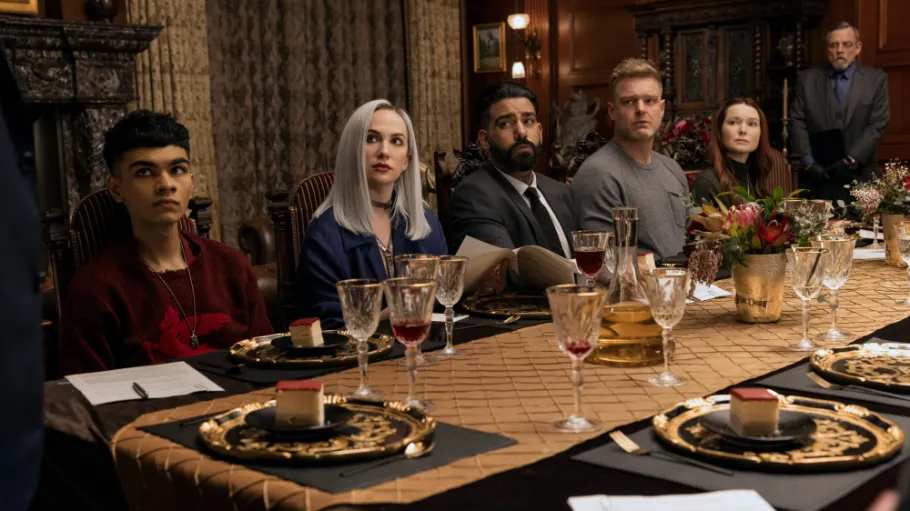Mike Flanagan is the creator of the forthcoming Netflix gothic horror drama miniseries The Fall of the House of Usher. The story follows The CEO of a dishonest pharmaceutical company is confronted by his dubious history as his children begin passing away in horrifying and strange ways. Stories of horror and mystery in the entertainment world frequently make us wonder: Could this terrifying tale have actually happened? One such mystery relates to the upcoming Netflix series “The Fall of the House of Usher.”
Viewers are left wondering if this unsettling tale is based in reality due to its dark and cryptic narrative. In the midst of the suspense, the following terrifying premise establishes the scene. Let’s investigate the story’s genesis and delve into the eerie incidents that inform its narrative as we set out on a quest to discover the truth. Join us (tvacute.com) in this investigation to determine whether “The Fall of the House of Usher” is based on real events or just a brilliant piece of fiction.
Is Netflix’s “The Fall of the House of Usher” Based on a True Story?
The story behind “The Fall of the House of Usher” is deeply entwined in both literary and historical narratives. The creative brilliance of Edgar Allan Poe drew inspiration from a variety of sources, weaving a complicated web that gives the story levels of depth. Although the series is based on Poe’s short story of the same name. The Hezekiah Usher House in Boston, Massachusetts, served as a fascinating inspiration for the novel. Additionally, Poe’s story contains echoes of Heinrich Clauren’s “Das Raubschloß” and E.T.A. Hoffmann’s “Das Majorat” from Germany. The seminal novel “The Castle of Otranto” by Horace Walpole is where the notion of a dilapidated and haunted castle, a key component of “The Fall of the House of Usher,” originates.
A Source of Inspiration: The Hezekiah Usher House?
The Hezekiah Usher House, a historic building located in the heart of contemporary Boston, Massachusetts, is one intriguing candidate. This mysterious mansion, which was built in 1684 and was next to Boston Common, was eventually either demolished or moved in 1830. But what mysteries did this home harbor, and may it have contributed to Poe’s story?
Some authors claim that Poe’s story may have been inspired by the events that took place inside the Hezekiah Usher House. A sailor and the younger wife of the older owner are rumored to have been found in the house’s hidden trysting chamber and buried there. Two victims were discovered inside a cellar hollow when the building’s foundation was being torn down, locked in an unbreakable embrace. Could Poe’s inspiration have been sparked by these awful events?
Mr. and Mrs. Luke Usher
The relationship between Poe’s characters and real-life people is another topic worth investigating. Eliza Poe’s friends and acting colleagues Mr. and Mrs. Luke Usher take on interesting new roles in this situation. Mr. and Mrs. Luke Usher, who were friends and performing partners of his mother Eliza Poe, could be another source of influence. Throughout Eliza’s illness and subsequent passing, the couple raised her three kids, including Poe. Could the connections made during this trying time have permeated Poe’s writing, bringing the characters that now appear on our screens to life?
Literature’s Interconnected Web: Hoffmann and Clauren
As we continue on, we come across the complex web of literary influences that created Poe’s story. Both “Das Majorat” by E.T.A. Hoffmann and “Das Raubschloß” (also known as “The Robber’s Tower”) by Heinrich Clauren are involved. There are creepy sounds, a story inside a story, and even the name “Roderich” that draw comparisons between these stories and “The Fall of the House of Usher.” There is no doubt that Poe’s knowledge of these works had an influence on his writing, obscuring the distinction between inspiration and originality.
Castle of Otranto’s Gothic influences are shown
It would be impossible to discuss literary influences without including Horace Walpole’s “Castle of Otranto.” This novel, which was published in 1764, had a major impact on the Gothic genre by popularizing the idea of haunted, decaying castles, a topic that later appeared in “The Fall of the House of Usher.” Poe skillfully incorporated mystery, the paranormal, and a sense of impending doom into his story, which is essential to the Gothic subgenre.
Let’s now examine the terrifying incidents that occur within the series itself. Roderick Usher is the CEO of a dishonest pharmaceutical business, and when viewers are dragged into the world of “The Fall of the House of Usher,” they come across him. His past is cloaked in mystery. As each of his children suffers an unfathomable and cruel fate, the suspense grows, forcing Roderick to face the ghosts that stalk his existence.
Themes of greed, terror, and tragedy weave together throughout the story as it progresses, echoing the core of Poe’s original tale. The show expertly transitions between the present and flashbacks from the Usher family’s past, resulting in a seamless blending of timeframes that captivates viewers.
The question of “The Fall of the House of Usher‘s” veracity continues as we explore the tapestry of influences that shaped it. Although the series is a work of fiction, it cannot be denied that real-world events, interpersonal relationships, and literary inspirations all had a part in its production. Edgar Allan Poe’s literary talent and the production team at Netflix have combined their creative vision to blur the lines between truth and fiction, giving viewers a unique experience.
Therefore, keep in mind that even though the particular events might not have occurred as represented, the strands of fact, intertwined with imagination, have formed a tale that will leave an enduring impression on your mind as you get ready to immerse yourself in “The Fall of the House of Usher.” The series asks us to consider not just what is on the screen, but also the very essence of the stories that engage our senses as it combines history, literature, and pleasure.
